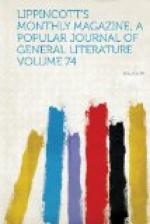* * * * *
So answered those strange horsemen,
And each couched low his spear;
And forthwith all the ranks of Rome
Were bold and of good cheer:
And on the thirty armies
Came wonder and affright,
And Ardea wavered on the left,
And Cora on the right.
“Rome to the charge!” cried
Aulus;
“The foe begins to yield!
Charge for the hearth of Vesta!
Charge for the Golden Shield!
Let no man stop to plunder,
But slay, and slay, and slay;
The gods who live for ever
Are on our side to-day.”
Then the fierce trumpet-flourish
From earth to heaven arose;
The kites know well the long stern swell
That bids the Romans close.
* * * * *
And fliers and pursuers
Were mingled in a mass:
And far away the battle
Went roaring through the pass.
The scene of the following stanza is at Rome, where the watchers at the gates have learned from the Great Twin Brethren the issue of the day:
And all the people trembled,
And pale grew every cheek;
And Sergius, the High Pontiff,
Alone found voice to speak:
“The gods who live for ever
Have fought for Rome to-day!
These be the Great Twin Brethren
To whom the Dorians pray!”
Of course, we are not to be understood as intimating that Macaulay was consciously or otherwise guilty of a plagiarism. Indeed, he was at the pains, in his preface to the poem in question, to point out how certain of its features were designedly taken, and others might fairly be conceived to have been taken, from ballads of an age long before Livy, whom he cites in the matter of the Great Twin Brethren. He has even detailed a circumstance, in reference to the legendary appearance of the divine warriors, curiously relevant to the resemblance just pointed out. “In modern times,” he wrote, “a very similar story actually found credence among a people much more civilized than the Romans of the fifth century before Christ. A chaplain of Cortez, writing about thirty years after the conquest of Mexico, ... had the face to assert that, in an engagement against the Indians, Saint James had appeared on a gray horse at the head of the Castilian adventurers. Many of those adventurers were living when this lie was printed. One of them, honest Bernal Diaz, wrote an account of the expedition.... He says that he was in the battle, and that he saw a gray horse with a man on his back, but that the man was, to his thinking, Francesco de Morla, and not the ever-blessed apostle Saint James. ‘Nevertheless,’ Bernal adds, ’it may be that the person on the gray horse was the glorious apostle Saint James, and that I, sinner that I am, was unworthy to see him.’” Other striking instances of identity between classical, Castilian and Saxon legends are detailed by Lord Macaulay in the learned and interesting general preface to his Lays of Ancient Rome. But the reappearance of this particular story in such remote times and places, and with such marked similarities and variations, would entitle it to a place among the indestructible popular legends collated by Mr. Baring-Gould in his Curious Myths of the Middle Ages.




